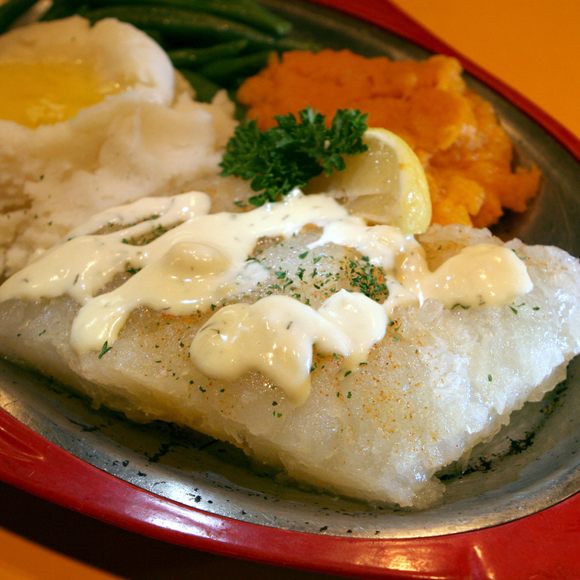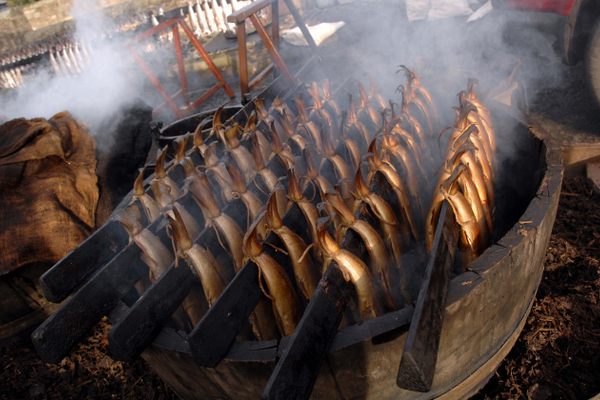Prepared Foods
Lutefisk
The lye-soaked fish recipe created by Vikings is now a holiday favorite at Midwestern church dinners.
Lye is a caustic substance that serial killers use to dissolve dead bodies and janitors use to clean clogged drains. For centuries, Scandinavians have used it to prepare dried whitefish, typically cod, in a dish known as lutefisk.
We have the Vikings to thank for the unique technique, which rehydrates dried fish in alternating containers of water and lye. The origin story recounts a Viking raid on a group of fishermen who had left their cod out to dry on birch racks. The raiders started to burn everything, even the fish, but a rainstorm swooped in. The scorched seafood soaked in rain puddles with a soupçon of birch ash for months until another group of Vikings found the cod and cooked up a feast. (Although that’s an exciting story, it’s more likely the Vikings made lutefisk as a creative way of getting around a lack of local salt deposits, the more traditional way of preserving fish in Northern Europe.)
As a result of lengthy periods of soaking in water and lye, the cod takes on a jelly-like consistency. If not prepared by an experienced chef, it will also emit a pungent, ammonia-like aroma (akin to Iceland’s dried fermented shark). The flavor, however, is subtle and cries out for condiments. Norwegians traditionally lather on melted butter, while Swedes (who refer to it as lutfisk) add white sauce. Diners commonly enjoy the fish alongside potatoes and green peas.
Though lutefisk is still a traditional Christmas dish in Sweden, Norway, and Finland, it’s most popular among the descendants of Scandinavian immigrants in the United States. Lutheran churches in the Midwest and Pacific Northwest hold special lutefisk dinners during the Christmas season. Madison, Minnesota, the self-proclaimed “lutefisk capital of the world,” goes one step further, expressing its lutefisk love with a statue. Its name? Lou T. Fisk.
Where to Try It
-
Håndverkerstuene
Rosenkrantzgate 7, Sentrum, Oslo, 0159, NorwayThis Oslo-based restaurant serves Norwegian cuisine along with an extensive beer list.
-
During Christmastime, their menu boasts plenty of traditional fare, including rakfisk, pinnekjøtt, and lutefisk.
Written By
 jwalker
jwalker
Sources
- www.smithsonianmag.com/travel/scandinavians-strange-holiday-lutefisk-tradition-2218218/
- www.npr.org/sections/thesalt/2016/12/15/505389094/whats-a-holiday-without-lutefisk-and-a-little-white-lye
- books.google.com/books?id=bz7qHmtb0bkC&pg=PA128&dq=lutefisk&hl=en&sa=X&ved=0ahUKEwiI6cPw7enaAhXQl-AKHQ-pBJ4Q6AEINjAE#v=onepage&q=lutefisk&f=false
- abcnews.go.com/Technology/story?id=4828249&page=1
- isthmus.com/food-drink/reviews/fringe-foods-lutefisk-dinner-at-lakeview-lutheran-church-in-madison/













